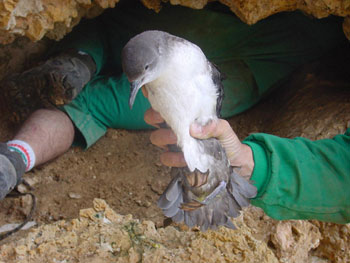SeaWatch SW is a volunteer-based project in the United Kingdom that started in 2007. The main aim is to improve understanding of the distribution and behaviour of migratory marine megafauna in the region, both for scientific and conservation purposes, especially of the Critically Endangered Balearic Shearwater Puffinus mauretanicus. This shearwater has been identified by the Albatross and Petrel Agreement as a potential candidate for listing (click here).
The project's annual report's for 2009 summarizes its findings on the shearwater as follows:
"A total of 983 Balearic Shearwater records were received from the UK and Ireland in 2009, relating to a maximum of 4824 birds. Numbers reported over the three years 2007-09 have therefore remained stable, with the number of records averaging about 900 (±100) per year and the maximum number of birds seen averaging about 5100 (±300) per year. It should be noted that these maximum totals will include significant duplication, as some birds may remain in an area for several days or are recorded passing multiple watchpoints. The temporal distribution of Balearic Shearwater sightings in 2009 was comparable to 2007 and 2008. The now expected mid-winter influx into southwest England was noted in January, but very few were then seen until birds began returning to southern England in May. The June total was lower than expected, but numbers rapidly increased to a peak between July and October. Regular records came from southwest England up to mid-December, but few were seen elsewhere in the late winter. As with previous years, about two-thirds of records came from southwest England, particularly Cornwall, Devon and Dorset. About 9% of records came from Ireland and 7% from Wales, with less than 2% from Scotland. Sightings away from southwest England peaked in August and September. The highest day total was a record Devon count of 145 off Berry Head on 2 Sept. Overall, the spatiotemporal distribution of Balearic Shearwater sightings in 2007-09 has been remarkably consistent."
The complete Executive Summary has also been published in Sea Swallow, Annual Report of the Royal Naval Birdwatching Society, in Vol. 59 of 2010. (pp. 46-55). Earlier annual reports of Seawatch SW may be found on its web site.
Reference:
Wynn, R.B., Brereton, T.M., Jones, A.R. & Lewis, K.M. 2010. SeaWatch SW Annual Report 2009. Southampton: National Oceanography Centre. 118 pp. http://www.seawatch-sw.org/downloads/SWSW_AR2009_long.pdf.
John Cooper, ACAP Information Officer, 6 January 2011

 English
English  Français
Français  Español
Español 